ACC00716 S1 2019: Make vs. Buy Analysis for DuoLever Limited
VerifiedAdded on 2023/03/21
|9
|1277
|80
Report
AI Summary
This finance report provides a comprehensive analysis of DuoLever Limited's decision to either manufacture recycled plastic sachets in-house or outsource production. The report employs an incremental cash flow approach to evaluate both options, considering initial investments, tax benefits, additional SG&A costs, and potential sales and cost benefits. The analysis includes a Net Present Value (NPV) calculation for each scenario, along with scenario and sensitivity analyses to assess the impact of uncertain variables such as sales forecasts and interest rates. The report also considers the implications of outsourcing to Clean World, including the absence of capital investment and reduced SG&A costs. The study concludes with a recommendation based on the quantitative analysis, highlighting the superior NPV and reduced risk associated with the outsourcing option, while also acknowledging the need to consider technology theft and long-term strategic implications. The report provides a detailed financial evaluation, including the calculation of expected NPV under optimistic and pessimistic scenarios for both options.
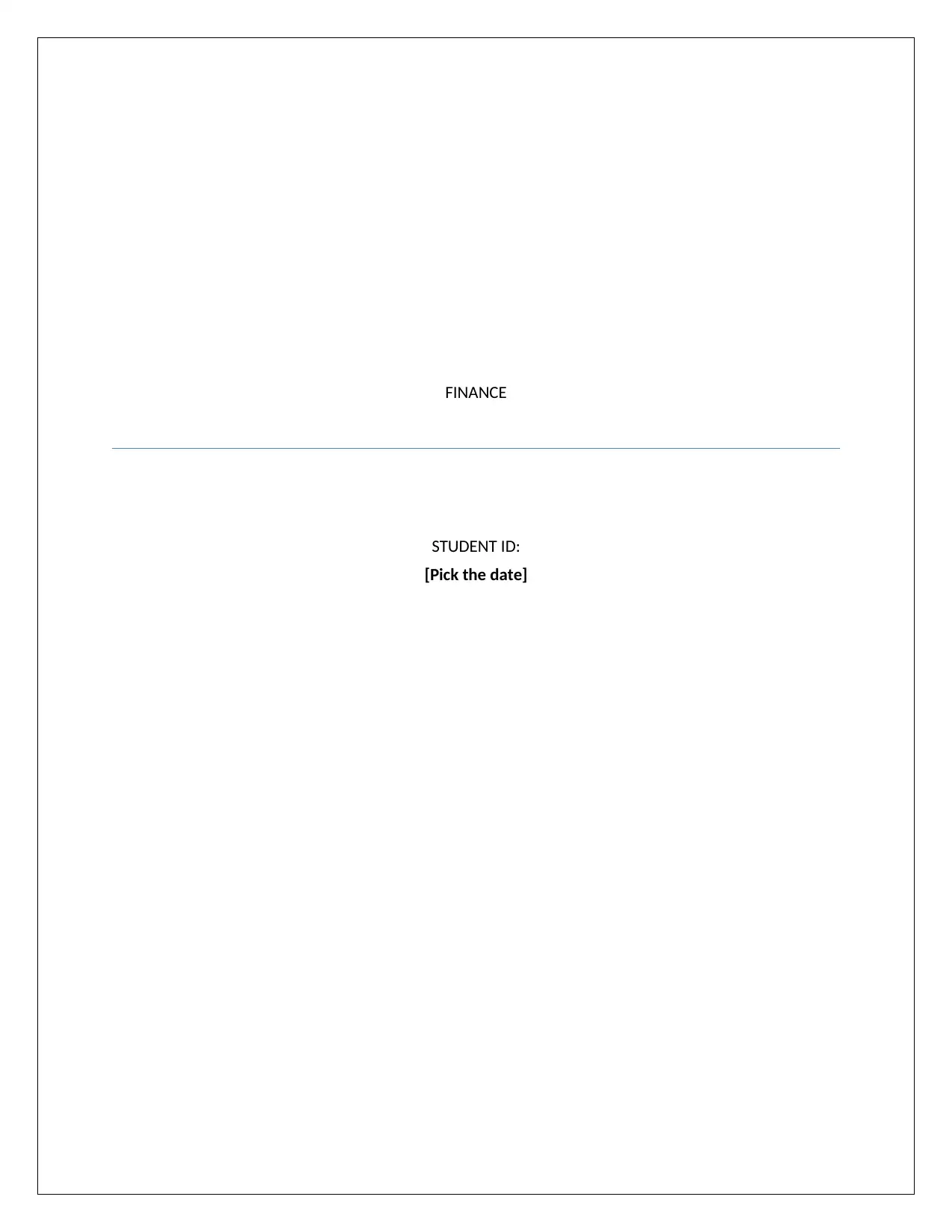
FINANCE
STUDENT ID:
[Pick the date]
STUDENT ID:
[Pick the date]
Paraphrase This Document
Need a fresh take? Get an instant paraphrase of this document with our AI Paraphraser
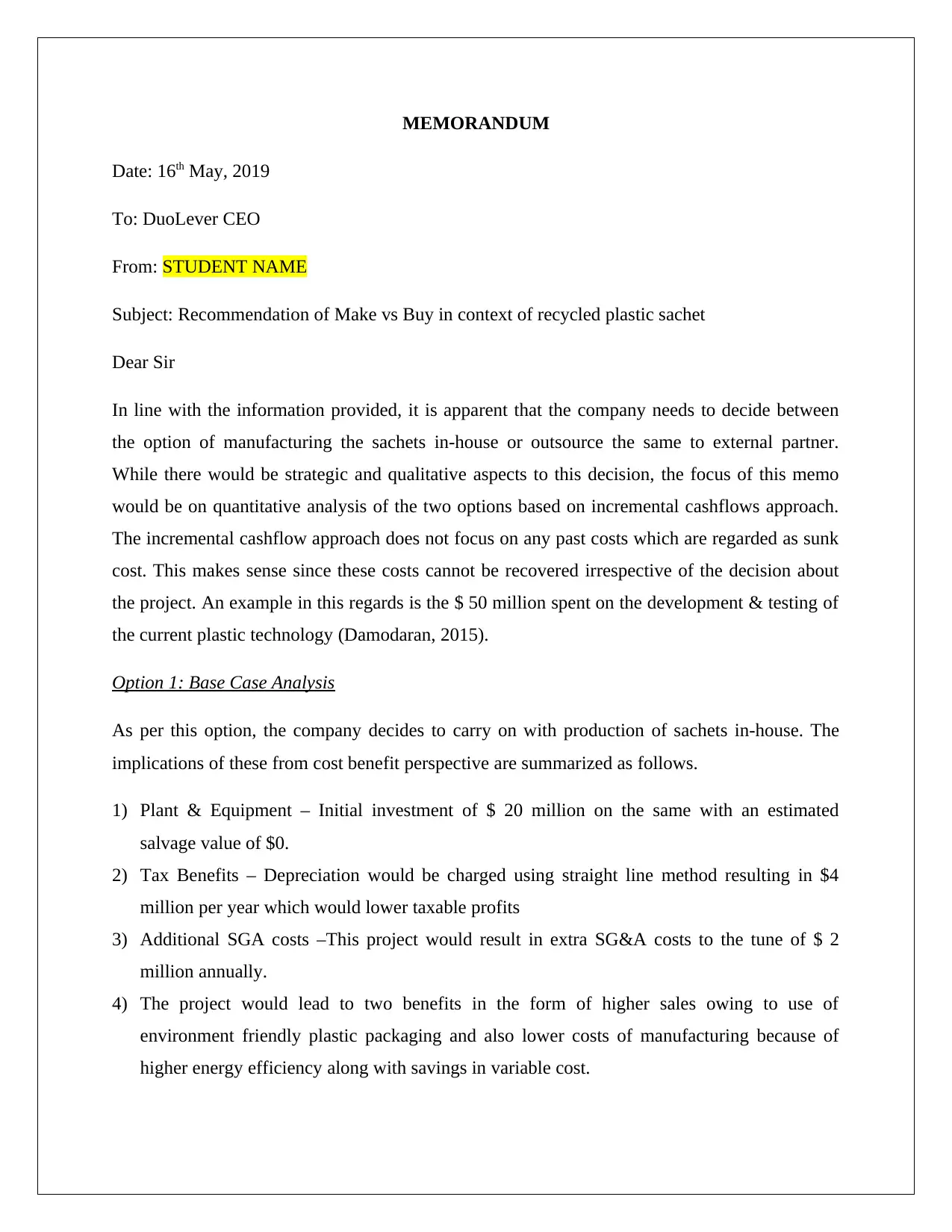
MEMORANDUM
Date: 16th May, 2019
To: DuoLever CEO
From: STUDENT NAME
Subject: Recommendation of Make vs Buy in context of recycled plastic sachet
Dear Sir
In line with the information provided, it is apparent that the company needs to decide between
the option of manufacturing the sachets in-house or outsource the same to external partner.
While there would be strategic and qualitative aspects to this decision, the focus of this memo
would be on quantitative analysis of the two options based on incremental cashflows approach.
The incremental cashflow approach does not focus on any past costs which are regarded as sunk
cost. This makes sense since these costs cannot be recovered irrespective of the decision about
the project. An example in this regards is the $ 50 million spent on the development & testing of
the current plastic technology (Damodaran, 2015).
Option 1: Base Case Analysis
As per this option, the company decides to carry on with production of sachets in-house. The
implications of these from cost benefit perspective are summarized as follows.
1) Plant & Equipment – Initial investment of $ 20 million on the same with an estimated
salvage value of $0.
2) Tax Benefits – Depreciation would be charged using straight line method resulting in $4
million per year which would lower taxable profits
3) Additional SGA costs –This project would result in extra SG&A costs to the tune of $ 2
million annually.
4) The project would lead to two benefits in the form of higher sales owing to use of
environment friendly plastic packaging and also lower costs of manufacturing because of
higher energy efficiency along with savings in variable cost.
Date: 16th May, 2019
To: DuoLever CEO
From: STUDENT NAME
Subject: Recommendation of Make vs Buy in context of recycled plastic sachet
Dear Sir
In line with the information provided, it is apparent that the company needs to decide between
the option of manufacturing the sachets in-house or outsource the same to external partner.
While there would be strategic and qualitative aspects to this decision, the focus of this memo
would be on quantitative analysis of the two options based on incremental cashflows approach.
The incremental cashflow approach does not focus on any past costs which are regarded as sunk
cost. This makes sense since these costs cannot be recovered irrespective of the decision about
the project. An example in this regards is the $ 50 million spent on the development & testing of
the current plastic technology (Damodaran, 2015).
Option 1: Base Case Analysis
As per this option, the company decides to carry on with production of sachets in-house. The
implications of these from cost benefit perspective are summarized as follows.
1) Plant & Equipment – Initial investment of $ 20 million on the same with an estimated
salvage value of $0.
2) Tax Benefits – Depreciation would be charged using straight line method resulting in $4
million per year which would lower taxable profits
3) Additional SGA costs –This project would result in extra SG&A costs to the tune of $ 2
million annually.
4) The project would lead to two benefits in the form of higher sales owing to use of
environment friendly plastic packaging and also lower costs of manufacturing because of
higher energy efficiency along with savings in variable cost.
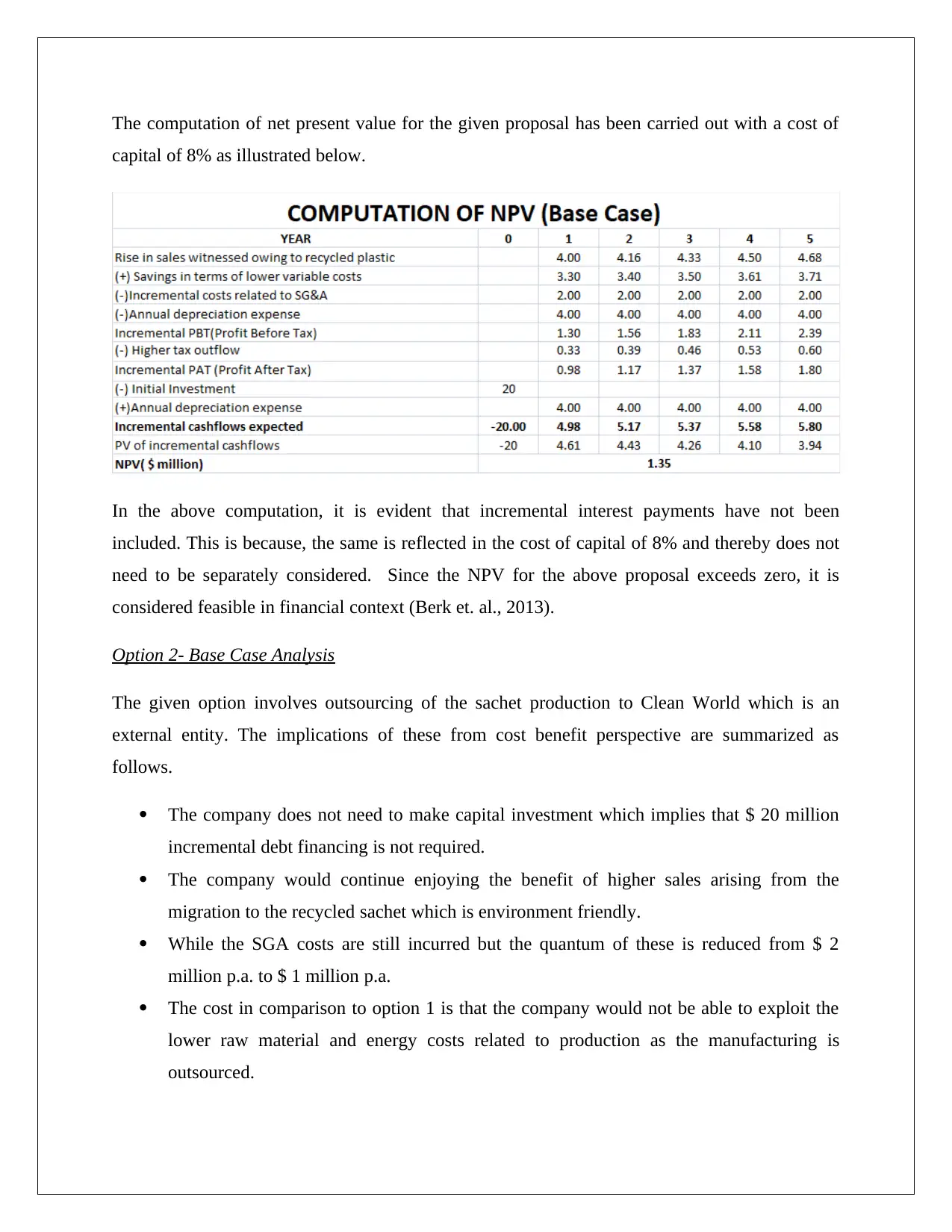
The computation of net present value for the given proposal has been carried out with a cost of
capital of 8% as illustrated below.
In the above computation, it is evident that incremental interest payments have not been
included. This is because, the same is reflected in the cost of capital of 8% and thereby does not
need to be separately considered. Since the NPV for the above proposal exceeds zero, it is
considered feasible in financial context (Berk et. al., 2013).
Option 2- Base Case Analysis
The given option involves outsourcing of the sachet production to Clean World which is an
external entity. The implications of these from cost benefit perspective are summarized as
follows.
The company does not need to make capital investment which implies that $ 20 million
incremental debt financing is not required.
The company would continue enjoying the benefit of higher sales arising from the
migration to the recycled sachet which is environment friendly.
While the SGA costs are still incurred but the quantum of these is reduced from $ 2
million p.a. to $ 1 million p.a.
The cost in comparison to option 1 is that the company would not be able to exploit the
lower raw material and energy costs related to production as the manufacturing is
outsourced.
capital of 8% as illustrated below.
In the above computation, it is evident that incremental interest payments have not been
included. This is because, the same is reflected in the cost of capital of 8% and thereby does not
need to be separately considered. Since the NPV for the above proposal exceeds zero, it is
considered feasible in financial context (Berk et. al., 2013).
Option 2- Base Case Analysis
The given option involves outsourcing of the sachet production to Clean World which is an
external entity. The implications of these from cost benefit perspective are summarized as
follows.
The company does not need to make capital investment which implies that $ 20 million
incremental debt financing is not required.
The company would continue enjoying the benefit of higher sales arising from the
migration to the recycled sachet which is environment friendly.
While the SGA costs are still incurred but the quantum of these is reduced from $ 2
million p.a. to $ 1 million p.a.
The cost in comparison to option 1 is that the company would not be able to exploit the
lower raw material and energy costs related to production as the manufacturing is
outsourced.
⊘ This is a preview!⊘
Do you want full access?
Subscribe today to unlock all pages.

Trusted by 1+ million students worldwide
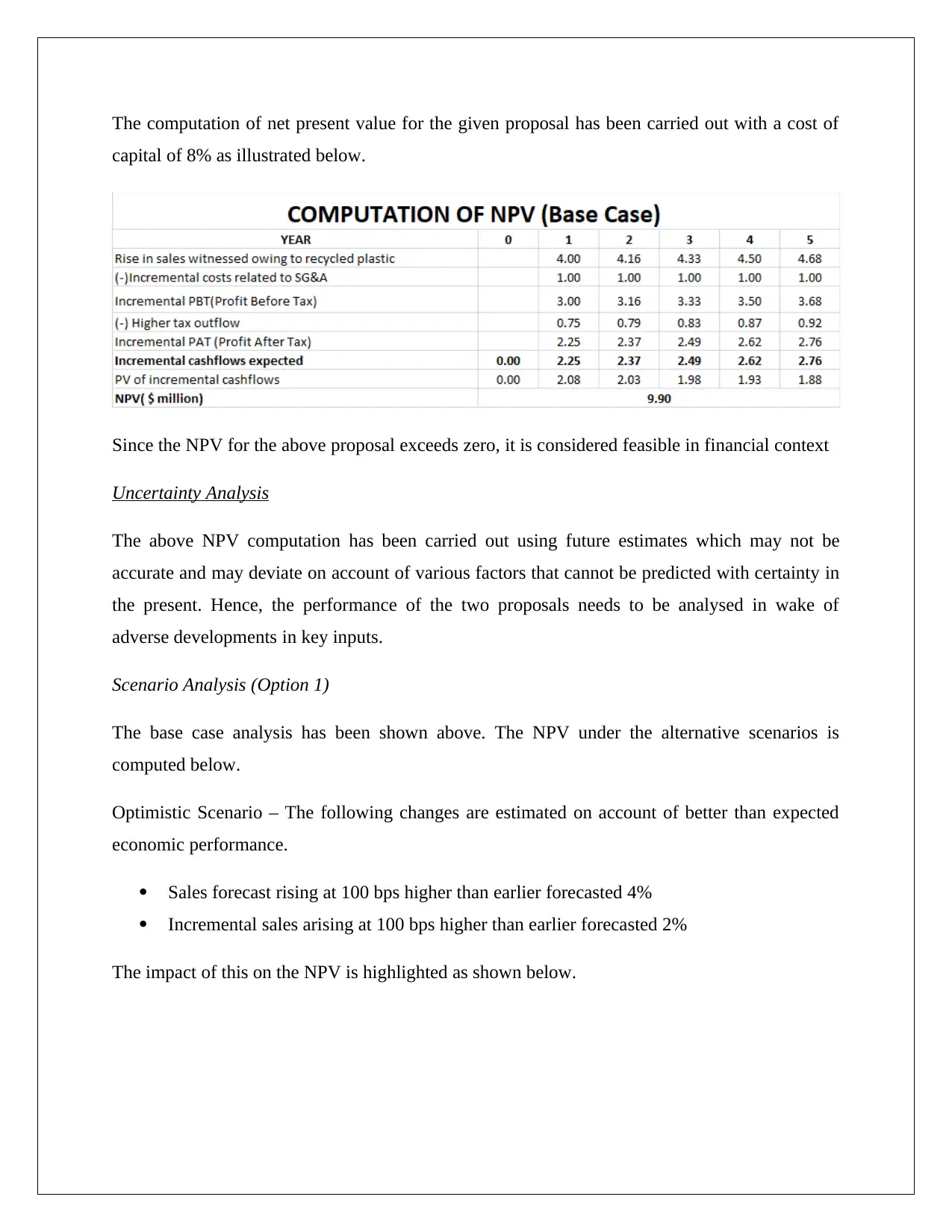
The computation of net present value for the given proposal has been carried out with a cost of
capital of 8% as illustrated below.
Since the NPV for the above proposal exceeds zero, it is considered feasible in financial context
Uncertainty Analysis
The above NPV computation has been carried out using future estimates which may not be
accurate and may deviate on account of various factors that cannot be predicted with certainty in
the present. Hence, the performance of the two proposals needs to be analysed in wake of
adverse developments in key inputs.
Scenario Analysis (Option 1)
The base case analysis has been shown above. The NPV under the alternative scenarios is
computed below.
Optimistic Scenario – The following changes are estimated on account of better than expected
economic performance.
Sales forecast rising at 100 bps higher than earlier forecasted 4%
Incremental sales arising at 100 bps higher than earlier forecasted 2%
The impact of this on the NPV is highlighted as shown below.
capital of 8% as illustrated below.
Since the NPV for the above proposal exceeds zero, it is considered feasible in financial context
Uncertainty Analysis
The above NPV computation has been carried out using future estimates which may not be
accurate and may deviate on account of various factors that cannot be predicted with certainty in
the present. Hence, the performance of the two proposals needs to be analysed in wake of
adverse developments in key inputs.
Scenario Analysis (Option 1)
The base case analysis has been shown above. The NPV under the alternative scenarios is
computed below.
Optimistic Scenario – The following changes are estimated on account of better than expected
economic performance.
Sales forecast rising at 100 bps higher than earlier forecasted 4%
Incremental sales arising at 100 bps higher than earlier forecasted 2%
The impact of this on the NPV is highlighted as shown below.
Paraphrase This Document
Need a fresh take? Get an instant paraphrase of this document with our AI Paraphraser
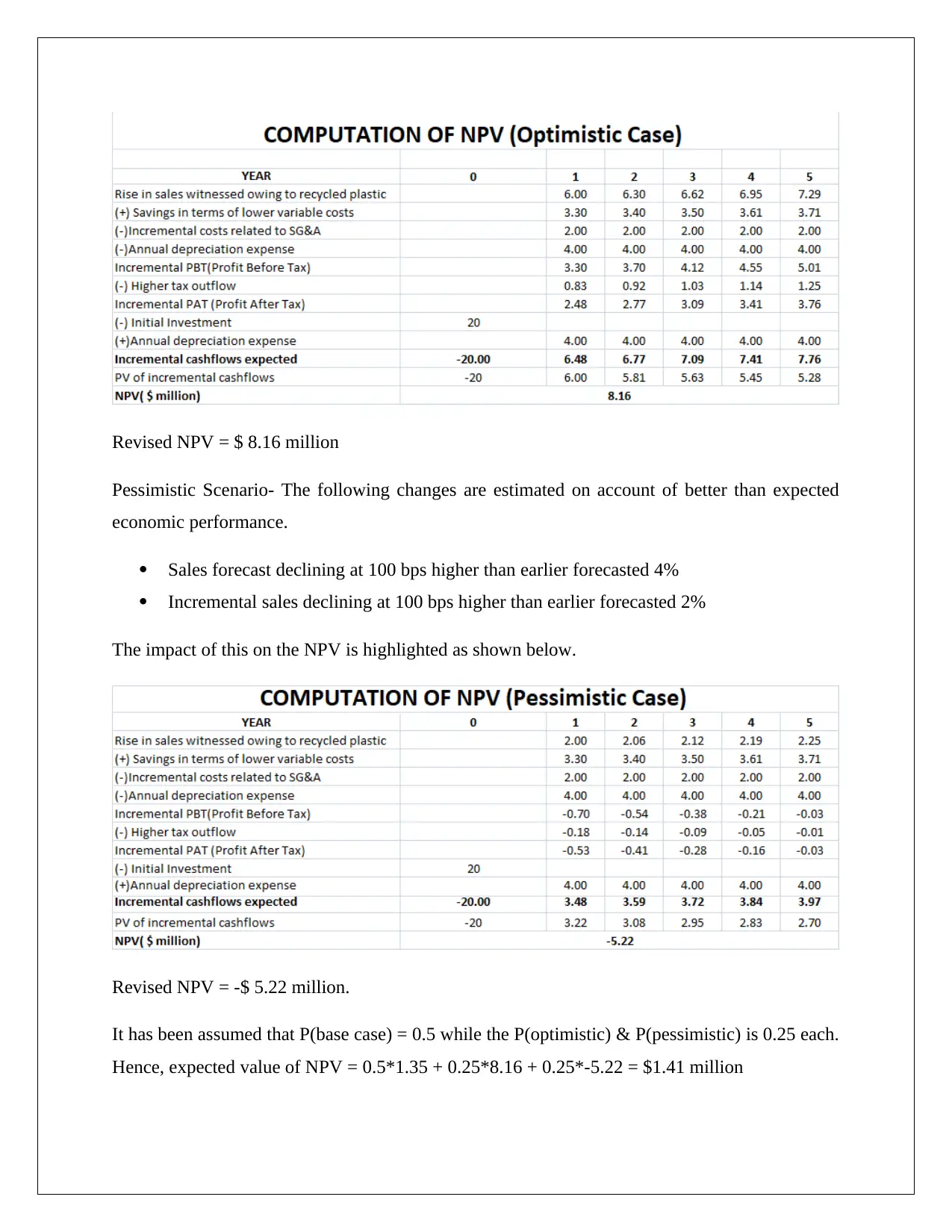
Revised NPV = $ 8.16 million
Pessimistic Scenario- The following changes are estimated on account of better than expected
economic performance.
Sales forecast declining at 100 bps higher than earlier forecasted 4%
Incremental sales declining at 100 bps higher than earlier forecasted 2%
The impact of this on the NPV is highlighted as shown below.
Revised NPV = -$ 5.22 million.
It has been assumed that P(base case) = 0.5 while the P(optimistic) & P(pessimistic) is 0.25 each.
Hence, expected value of NPV = 0.5*1.35 + 0.25*8.16 + 0.25*-5.22 = $1.41 million
Pessimistic Scenario- The following changes are estimated on account of better than expected
economic performance.
Sales forecast declining at 100 bps higher than earlier forecasted 4%
Incremental sales declining at 100 bps higher than earlier forecasted 2%
The impact of this on the NPV is highlighted as shown below.
Revised NPV = -$ 5.22 million.
It has been assumed that P(base case) = 0.5 while the P(optimistic) & P(pessimistic) is 0.25 each.
Hence, expected value of NPV = 0.5*1.35 + 0.25*8.16 + 0.25*-5.22 = $1.41 million
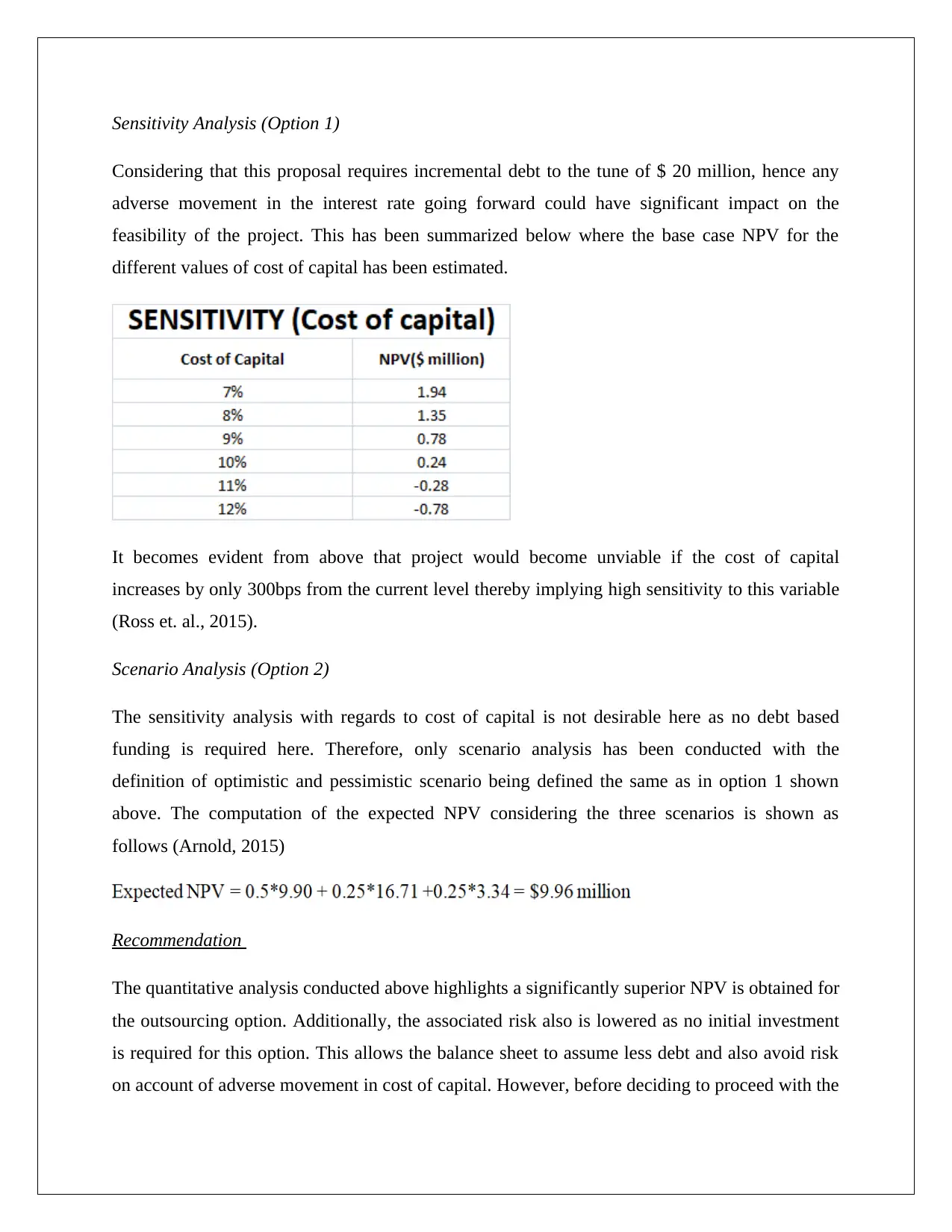
Sensitivity Analysis (Option 1)
Considering that this proposal requires incremental debt to the tune of $ 20 million, hence any
adverse movement in the interest rate going forward could have significant impact on the
feasibility of the project. This has been summarized below where the base case NPV for the
different values of cost of capital has been estimated.
It becomes evident from above that project would become unviable if the cost of capital
increases by only 300bps from the current level thereby implying high sensitivity to this variable
(Ross et. al., 2015).
Scenario Analysis (Option 2)
The sensitivity analysis with regards to cost of capital is not desirable here as no debt based
funding is required here. Therefore, only scenario analysis has been conducted with the
definition of optimistic and pessimistic scenario being defined the same as in option 1 shown
above. The computation of the expected NPV considering the three scenarios is shown as
follows (Arnold, 2015)
Recommendation
The quantitative analysis conducted above highlights a significantly superior NPV is obtained for
the outsourcing option. Additionally, the associated risk also is lowered as no initial investment
is required for this option. This allows the balance sheet to assume less debt and also avoid risk
on account of adverse movement in cost of capital. However, before deciding to proceed with the
Considering that this proposal requires incremental debt to the tune of $ 20 million, hence any
adverse movement in the interest rate going forward could have significant impact on the
feasibility of the project. This has been summarized below where the base case NPV for the
different values of cost of capital has been estimated.
It becomes evident from above that project would become unviable if the cost of capital
increases by only 300bps from the current level thereby implying high sensitivity to this variable
(Ross et. al., 2015).
Scenario Analysis (Option 2)
The sensitivity analysis with regards to cost of capital is not desirable here as no debt based
funding is required here. Therefore, only scenario analysis has been conducted with the
definition of optimistic and pessimistic scenario being defined the same as in option 1 shown
above. The computation of the expected NPV considering the three scenarios is shown as
follows (Arnold, 2015)
Recommendation
The quantitative analysis conducted above highlights a significantly superior NPV is obtained for
the outsourcing option. Additionally, the associated risk also is lowered as no initial investment
is required for this option. This allows the balance sheet to assume less debt and also avoid risk
on account of adverse movement in cost of capital. However, before deciding to proceed with the
⊘ This is a preview!⊘
Do you want full access?
Subscribe today to unlock all pages.

Trusted by 1+ million students worldwide
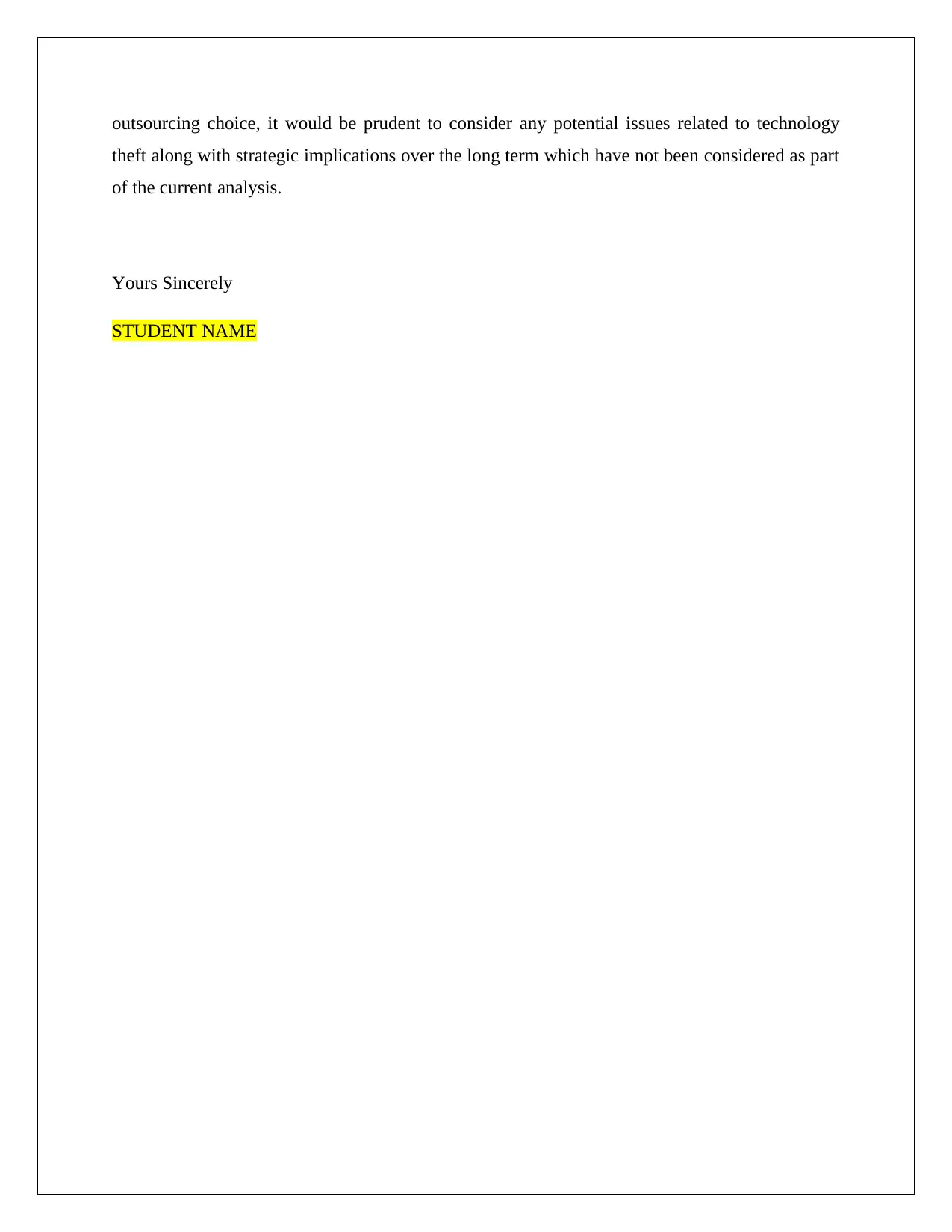
outsourcing choice, it would be prudent to consider any potential issues related to technology
theft along with strategic implications over the long term which have not been considered as part
of the current analysis.
Yours Sincerely
STUDENT NAME
theft along with strategic implications over the long term which have not been considered as part
of the current analysis.
Yours Sincerely
STUDENT NAME
Paraphrase This Document
Need a fresh take? Get an instant paraphrase of this document with our AI Paraphraser
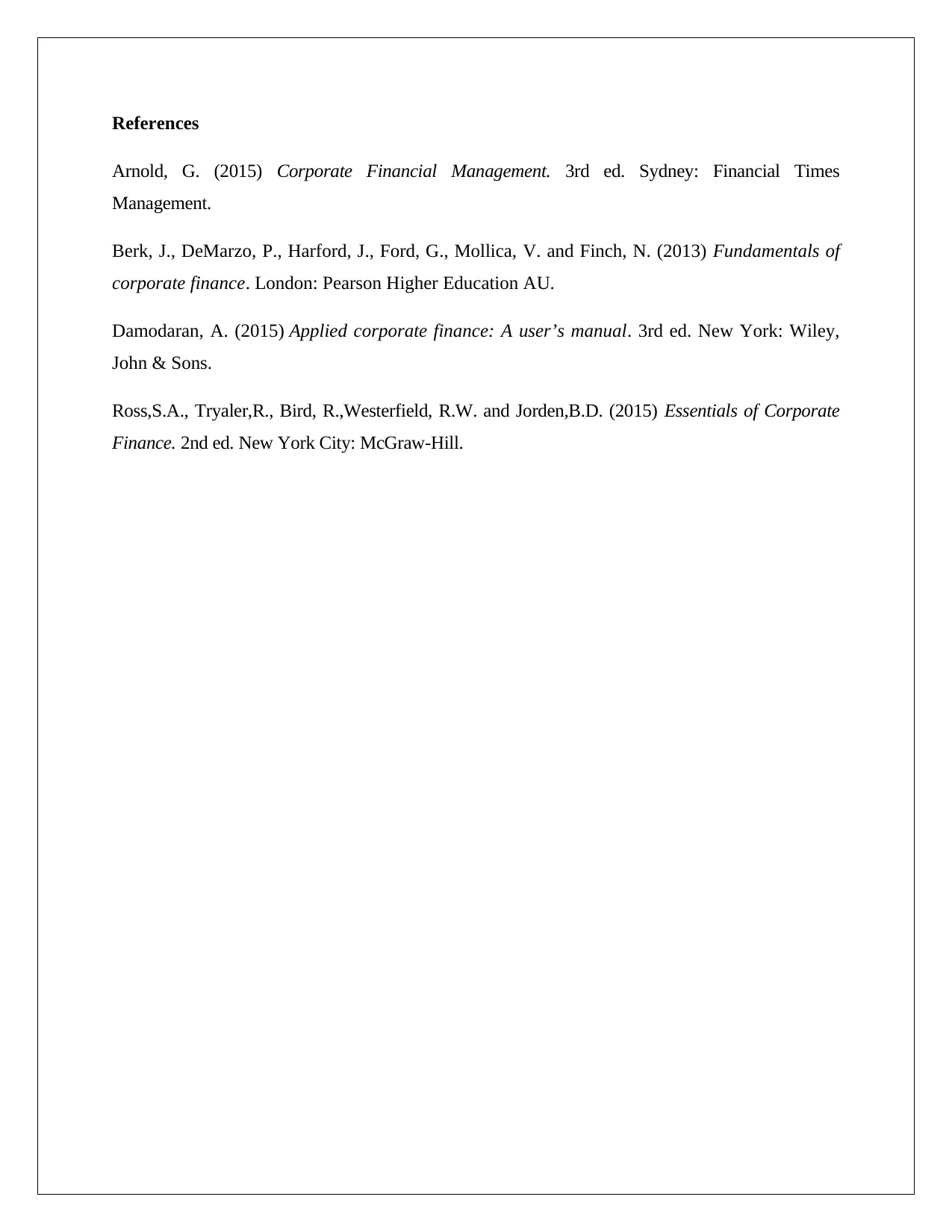
References
Arnold, G. (2015) Corporate Financial Management. 3rd ed. Sydney: Financial Times
Management.
Berk, J., DeMarzo, P., Harford, J., Ford, G., Mollica, V. and Finch, N. (2013) Fundamentals of
corporate finance. London: Pearson Higher Education AU.
Damodaran, A. (2015) Applied corporate finance: A user’s manual. 3rd ed. New York: Wiley,
John & Sons.
Ross,S.A., Tryaler,R., Bird, R.,Westerfield, R.W. and Jorden,B.D. (2015) Essentials of Corporate
Finance. 2nd ed. New York City: McGraw-Hill.
Arnold, G. (2015) Corporate Financial Management. 3rd ed. Sydney: Financial Times
Management.
Berk, J., DeMarzo, P., Harford, J., Ford, G., Mollica, V. and Finch, N. (2013) Fundamentals of
corporate finance. London: Pearson Higher Education AU.
Damodaran, A. (2015) Applied corporate finance: A user’s manual. 3rd ed. New York: Wiley,
John & Sons.
Ross,S.A., Tryaler,R., Bird, R.,Westerfield, R.W. and Jorden,B.D. (2015) Essentials of Corporate
Finance. 2nd ed. New York City: McGraw-Hill.
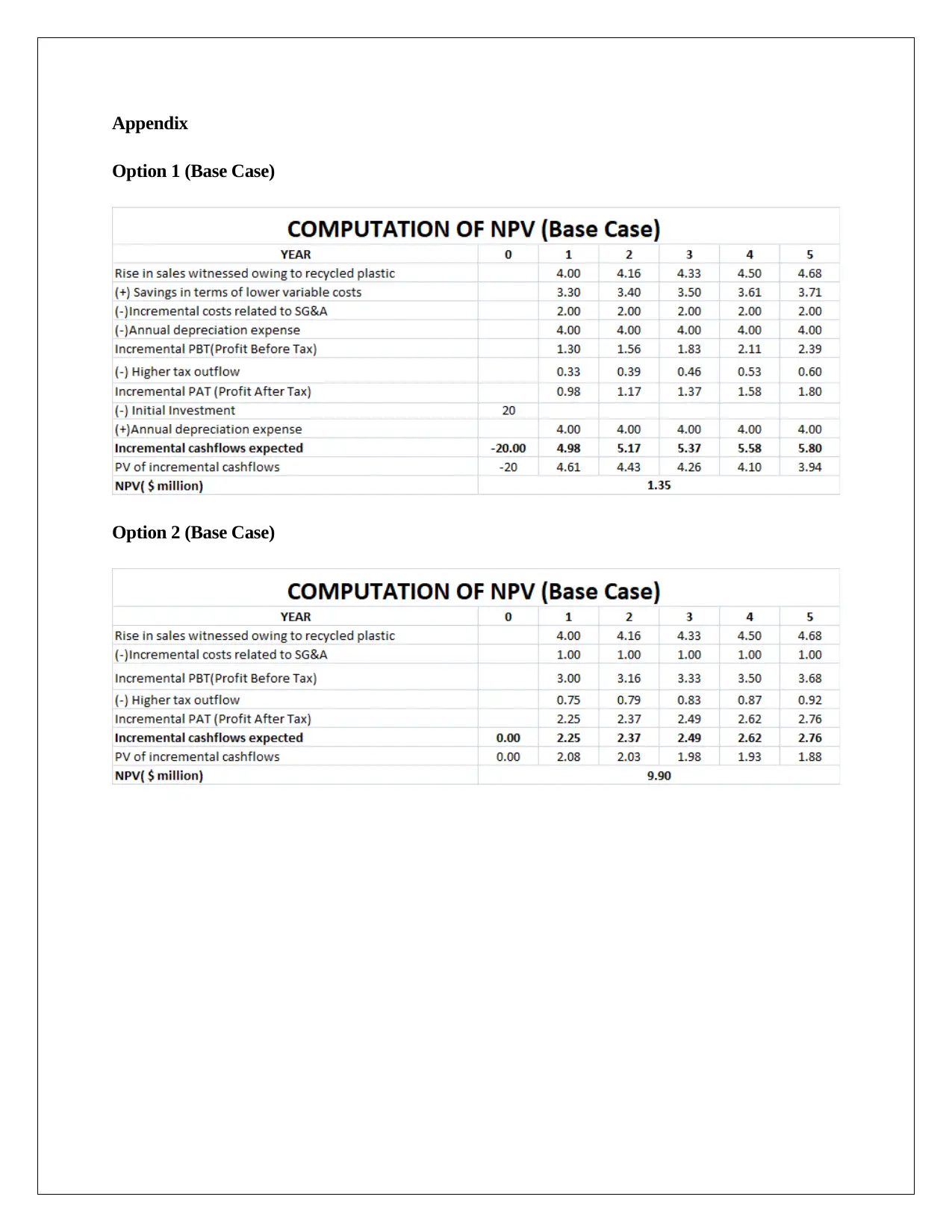
Appendix
Option 1 (Base Case)
Option 2 (Base Case)
Option 1 (Base Case)
Option 2 (Base Case)
⊘ This is a preview!⊘
Do you want full access?
Subscribe today to unlock all pages.

Trusted by 1+ million students worldwide
1 out of 9
Related Documents
Your All-in-One AI-Powered Toolkit for Academic Success.
+13062052269
info@desklib.com
Available 24*7 on WhatsApp / Email
![[object Object]](/_next/static/media/star-bottom.7253800d.svg)
Unlock your academic potential
Copyright © 2020–2025 A2Z Services. All Rights Reserved. Developed and managed by ZUCOL.





